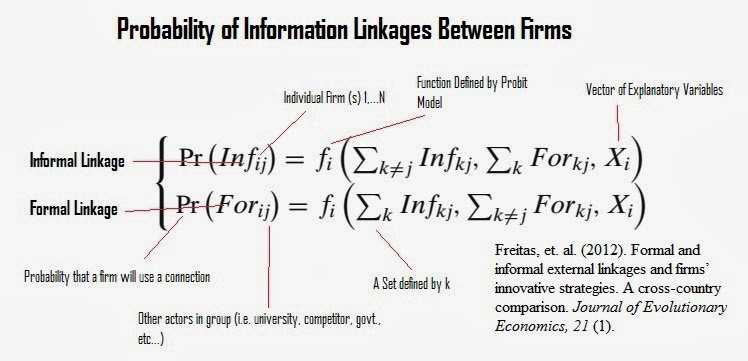Product and service innovation is not something that
occurs in a vacuum. It requires various connections throughout the market to
obtain the information and ideas to create marketable products and services.
Formal business connections, informal social connections, and formal research
institutes all have a hand in the success of the firms around them. Fretas, et.
al. (2011) discusses the complexity of these relationships and study which
types of connections firms pick to achieve objectives in different types of
companies.
Industrial innovation can be seen as a process that
involves the search for information and interaction with market actors such as
customers, competitors, and suppliers or research institutions like
universities or government to achieve their objectives (Salter and Martin,
2001). They develop several different types of formal and informal
relationships to obtain the information they need to create dynamic
interactions.
Prior research has found a relationship between
reliance on external informational sources and the desire to create greater
cooperative R& D agreements. Companies that desire to grow and seem to be
most open to collaboration efforts are the ones who actively seek out these
connections. They create formal agreements that help them collaborate with
others in their goals.
Simple innovation requires simple connections while
complex market breakthroughs require larger networks of connections. Simply
innovations occur when an enhancement to a product or services is developed and
implemented. When market busting products and services are created they require
a higher level of interaction and development.
Those companies that can develop better
formalization of networks do better at managing the data and advantages. It is
not enough to collect information from others without formatting that
information to create meaningful concepts. The systems in which this
formalization is developed and used will determine its fruitfulness.
The researchers use the following formula to
determine the likelihood of firms linking in their analysis:
The researchers use the formula to analyze the
different types of firms and how they are interrelated to each other to see if
different industries attracted different types of linkages. A high technology
firm will have different information needs than low technology firms. Each firm
and their competitors will create and enhance the informational sources that
are most beneficial to them.
That information must be collected, analyzed and put
within a framework that makes productive development possible. Improper
displays of information can mislead users who do not see the connections
between the information. How the information managed and interpreted between
these connections will determine the success of such relationships.
Results
Firms have several types of innovation strategies.
These strategies are based more on the position and needs of the company than
its country of origin. Innovation strategies impact the types of interactions and
connections firms make. For example, novel products have formal and informal interaction
with customers and research organizations. Firms that create improved products
use informal linkages with competitors and formal and informal links with
customers as information sources. Those that innovate both products and
processes rely on customers and public research organizations. To improve upon
their development firms will need to create both wider collaboration efforts and
methods of understanding the complex array of information available to them.
Freitas, et. al. (2012). Formal and
informal external linkages and firms’ innovative strategies. A cross-country
comparison. Journal of Evolutionary Economics,
21 (1).
Salter A. & Martin, B. (2001) The economic
benefits of publicly funded research: a critical review. Res Policy 30:509–539
